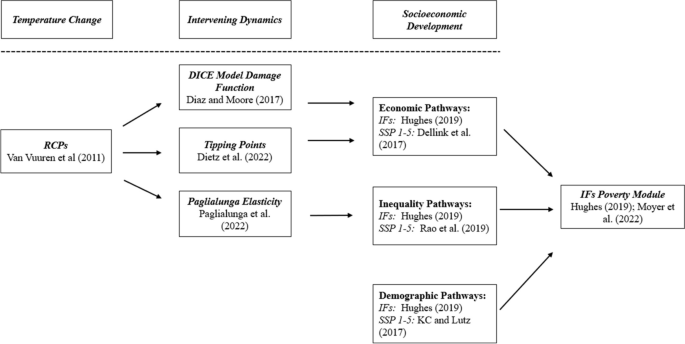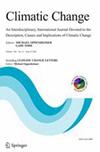How many people will live in poverty because of climate change? A macro-level projection analysis to 2070
IF 4.8
2区 环境科学与生态学
Q1 ENVIRONMENTAL SCIENCES
引用次数: 0
Abstract
Abstract Fossil fuel-based economic development both causes climate change and contributes to poverty alleviation, creating tensions across societal efforts to maintain growth, limit climate damage, and improve human development. While many studies explore key aspects of this dilemma, few direct attention to the pathways from climate change through socioeconomic development to the future of poverty. We build on projections of global temperature change (representative concentration pathways) and country-specific economic development (economic growth and income distribution across the shared socioeconomic pathways) to model how climate change may affect future poverty with the International Futures (IFs) model, projecting poverty across income thresholds for 175 countries through 2070. Central tendency scenarios with climate effects compared with scenarios that do not model climate change show that climate change-attributable extreme poverty will grow to 25 million people by 2030 (range: 18 to 30), 40 million by 2050 (range: 9 to 78), and 32 million by 2070 (range: 4 to 130) though overall levels of global poverty decline. If climatic tipping points are passed, the climate-attributable extreme poverty grows to 57 million people by 2030 (range: 40–72), 78 million by 2050 (range: 18–193), and 56 million by 2070 (range: 7–306). To mitigate baseline effects of climate change on extreme poverty, an improvement of global income inequality of 10% is required (range: 5–15%).

有多少人会因为气候变化而生活在贫困之中?对2070年的宏观预测分析
以化石燃料为基础的经济发展既导致了气候变化,也有助于减轻贫困,在维持增长、限制气候破坏和改善人类发展的社会努力中造成了紧张关系。虽然许多研究探讨了这一困境的关键方面,但很少有人直接关注气候变化通过社会经济发展到贫困未来的途径。我们基于对全球温度变化(代表性集中路径)和特定国家经济发展(跨共享社会经济路径的经济增长和收入分配)的预测,利用国际期货模型(IFs)模拟气候变化如何影响未来贫困,预测到2070年175个国家跨收入阈值的贫困。与不模拟气候变化的情景相比,有气候影响的集中趋势情景表明,尽管全球总体贫困水平下降,但到2030年,气候变化导致的极端贫困人口将增加到2500万人(范围:18至30),到2050年将增加到4000万人(范围:9至78),到2070年将增加到3200万人(范围:4至130)。如果超过气候临界点,到2030年,气候导致的极端贫困人口将增加到5700万人(范围:40-72),到2050年将增加到7800万人(范围:18-193),到2070年将增加到5600万人(范围:7-306)。为了减轻气候变化对极端贫困的基线影响,需要将全球收入不平等程度提高10%(范围:5-15%)。
本文章由计算机程序翻译,如有差异,请以英文原文为准。
求助全文
约1分钟内获得全文
求助全文
来源期刊

Climatic Change
环境科学-环境科学
CiteScore
10.20
自引率
4.20%
发文量
180
审稿时长
7.5 months
期刊介绍:
Climatic Change is dedicated to the totality of the problem of climatic variability and change - its descriptions, causes, implications and interactions among these. The purpose of the journal is to provide a means of exchange among those working in different disciplines on problems related to climatic variations. This means that authors have an opportunity to communicate the essence of their studies to people in other climate-related disciplines and to interested non-disciplinarians, as well as to report on research in which the originality is in the combinations of (not necessarily original) work from several disciplines. The journal also includes vigorous editorial and book review sections.
 求助内容:
求助内容: 应助结果提醒方式:
应助结果提醒方式:


